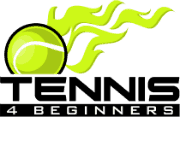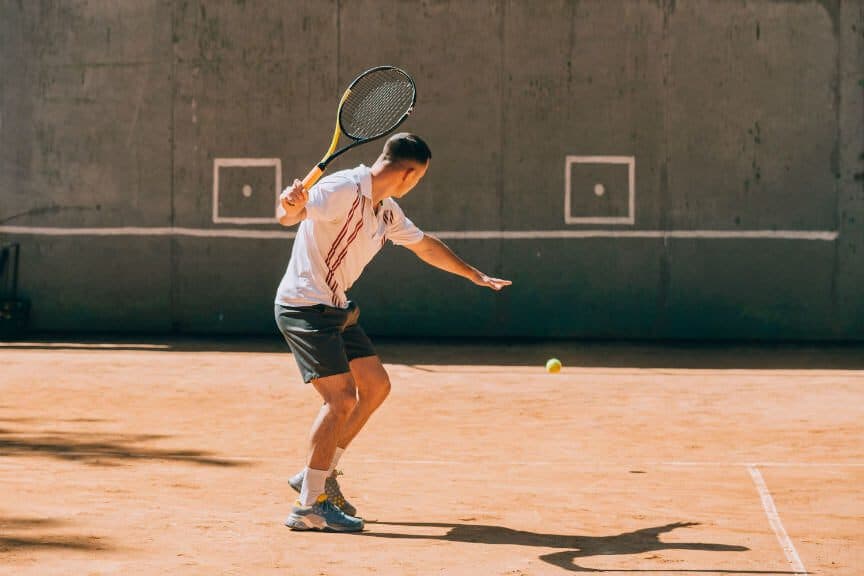Practicing tennis against a wall is one of the time-proven ways to improve your game. But in order for it to be effective, it’s important that you practice with good form. The repetitive nature of practice will instill either good or bad habits, so it’s important to remain focused.
In essence, when you hit against the wall you need to maintain the form you would use when playing a match or hitting against a partner. Set a goal beforehand of where you want to place the ball, what type of shots to take, and focus on form, consistency, and maintaining good eye contact with the ball. Most importantly, hold yourself accountable if your shots are off and work on improving any flaws.
By doing this you should see a noticeable improvement in your results. Hitting against a wall is a great way to practice on your own. Best of all, you don’t have to schedule it with anyone else, it’s always available for practice. But be sure to set goals beforehand.
Set a Goal Beforehand
Before you take your first swing, know what shots you will be taking. Will you be hitting forehand groundstrokes, backhand shots, or practicing volleys? Where do you want to place the ball, and are you going to use topspin, backspin, or hit flat shots?
Maybe you want to alternate between forehand and backhand and then approach the net, or backboard in this case, or maybe you want to serve, return serve, and then transition to groundstrokes. You can even take this a bit further and set goals for how many consecutive shots you want to take.
What’s important is to have your plan figured out beforehand. You don’t want to start hitting without a preset goal. This will significantly help you stay focused and allow you to hold yourself accountable if you fall short of your goal.
Focus on Your Form
Once you have your goal in place, you want to make sure that you hit with good form. Make sure you set up and perform each stroke the way you would during a match or at the very least when practicing with an opponent.
Are you bending your knees, setting up properly, and following through on your strokes? Are you using your non-hitting had as a guide? What about your footwork, are you moving your feet and setting your stance every time?
All of these factors are important. Be sure to refocus as soon as you find you are beginning to lose your form. This may happen from time to time, particularly when getting started. However over time, the more you focus on your form during practice, the more automatic it will become.
Maintain Good Eye Contact
Along with maintaining good form, keeping your eye on the ball is key to effective practice against the wall. It will help you stay much more focused on your shots. Good eye contact is critical to consistently hitting clean shots.
When you keep your focus on the ball, you increase the likelihood that you will make contact with the sweet spot of the racket. Your shots will feel better and your placement should see a significant improvement.
Work on Your Aim
Another thing to focus on when practicing against a wall is your aim. It’s tempting to just start hitting the ball and keep it in play. However, if you want to get the most out of the practice session, be sure to pick a spot to aim at and do so consistently.
You can simply mentally focus on a spot on the wall or backboard, or if you have painter’s tape (do not use duct tape or any other heavy stick tape) you can create a box to aim for. If the backboard or wall has a horizontal line at net height, this is a great way to make sure you are clearing the net.
Focus on Consistency
Along with your placement and form, you want to make sure your shots are consistent. If you are hitting a solid forehand or backhand and then following up with a sloppy shot, you need to clean this up as soon as possible.
The more consistent your strokes, the more natural they become. This is where you will begin to reap the benefits of practicing regularly against the wall. You want to make sure you build good muscle memory and mental habits so that they carry on to the court.
Hold Yourself Accountable
Setting up goals beforehand is important, but you need to keep yourself accountable if you fall short. By the same token, if your form is starting to waiver or your footwork is off, you need to catch it right away and correct it.
Remember, bad habits repeated over a period of time can become ingrained in your game. If you hold yourself accountable and ensure you are using proper form, then you will be more likely to develop good habits and reap the benefits over the long term.
Practice Drills
Doing drills helps you stay focused and practice through repetition. It also makes practicing against a wall or backboard more fun and challenging. It gives you a reference point to measure your progress and keep yourself accountable.
There are many drills you can do to improve the quality of practice against a wall. Some focus on timing, some on your overall form, and some on your reflexes, which is important up at the net. Try out some of these drills or create your own.
Warm-Ups
Warm-ups are a great way to start your practice session. Stand about 20 feet from the wall and just hit with little pace on both your forehand and backhand side. The idea is just to get warmed up and used to making good contact.
You can alternate between your forehand and backhand. For now, there is no need to use topspin. A flat forehand combined with a slice backhand is fine. The important thing is to focus on a target and make sure you are being consistent with your shots.
You can also practice your volleys this way, though you will need to step in a bit closer, about 6-8 ft from the wall. See what distance feels comfortable to you. Once you’ve been practicing this for a bit, you can begin to move further back from the wall.
Groundstrokes
As you move further back, about 35 feet from the wall, you can begin to put more pace on your shots. Now you will be practicing your forehand and backhand with topspin or backspin as you would normally on the court since you are at a further distance from the wall.
You can choose to let the ball bounce once or twice. With one bounce you will need to put greater pace on the ball and probably strike the wall a bit higher. One bounce will provide a more fast-paced workout. On the other hand, two bounces is closer in terms of timing to what you would experience on the court against an opponent.
Whether you chose one bounce or two bounce, be sure to be consistent with one or the other. Don’t alternate between the two, that’s not the point of this drill. Along with aim and consistency, your form and preparation on each shot are important at this point.
Overhead Smashes
In addition to groundstrokes and volleys, you can also practice your overhead shots against a wall. The main difference is that the ball will be striking the ground first, about 5 feet or so from the wall, and then ricocheting off the backboard or wall.
As the ball bounces back off the wall it will be at an elevated angle, similar to a lob. At this point, you will set up for the smash and once again strike the ball towards the ground roughly 5 feet from the wall. Be consistent with the target and pace.
With this drill, it’s important to set up correctly and follow through properly. You will likely need to shuffle your feet and sidestep back to adjust your shot. If you haven’t already, check out the article on how to hit an overhead smash.
Progression Drills
With progression drills, you will gradually move your target rather than always striking the same spot on a wall. On the forehand, for example, your shots would be just to the right (for right-handed players) each time. This will force you to have to step towards the ball each time. Repeat this until you get to the end of the wall.
Once at the end of the wall, you can reverse the shot to your backhand side and progress your shots on the backhand side. You want to hit the shot just off to the side so that you progressively step into the direction of the coming ball.
This can work with both your groundstrokes as well as your volleys. With the volleys, you will need to step in closer and the timing will be much quicker. Volleys take more practice and getting used to than groundstrokes, but practicing them against a wall can be very beneficial to your game.
Alternating Drills
Similar to the progression drill, alternating drills involve hitting your shots off-center, or at an angle. Rather than hitting continuously to one side, you will alternate between the forehand and backhand side.
This is a little different than the standard groundstroke routine in that you will need to step towards the ball each time since you are hitting your shots at an angle rather than straight in front. This is a good drill to get some added cardio benefits.
Practicing with a Partner
While most of the time you will be practicing against a wall by yourself, you can also mix it up a bit and play with an opponent. You can set up so that each player is on either side of the backboard, or simply rotate around each other on alternating shots.
The advantage of this drill vs just hitting against an opponent is the fast pace you will both experience. You will have less time to set up and react, so this is a good one to improve your reflexes and your speed. You can do this drill by focusing on groundstrokes or on volleys or a combination of the two.
Creating Your Own Drills
These are just a couple of ways you can practice against a wall, the possibilities are limitless. Don’t be afraid to experiment and try out new drills as they come to you during practice. The more you practice, the more variations you will be inclined to try.
There is no such thing as a good drill or bad drill as long as you stay focused on your form and execute it as intended. As always, plan your drills ahead of time so that you have something to measure your performance against and hold yourself accountable so that you continue to improve.
Share this Post

